The Branch Foundation works alongside marginalized communities in South-East Asia to support sustainable community development through education, capacity building and renewable energy solutions. Find out more about us on The Branch Foundation website.
Don't wanna be here? Send us removal request.
Text
Titirangi Rudolf Steiner School visits Koung Jor Shan Refugee Camp - January 2017
I left Aotearoa New Zeland on 23rd January with 7 graduate students for Thailand having done next to no research into what we were about to experience. This was true for the 17-19 year old group I was there to ‘support’ without taking a lead role as a teacher. One of the main aims of the trip was to let the graduates see something of the world beyond their experience at home, with a view to this leading them to a broader, more aware take on the world they were about to enter as adults.
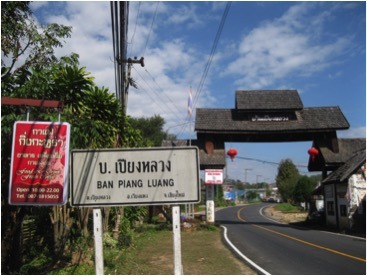
We went first to Chiang Mai in Northern Thailand. It is an easy-going city, hard not to like. From there, we would spend 4 nights in the remote town of Piang Luang near the border with Burma to see and help out at a refugee camp. Then it would be out in the the jungle inhabited by the Karen tribes to live very simply with those caring for 7 elephants as part of the “Journey to Freedom” programme before going to the elephant rescue centre, home of 71 elephants all saved from truly abysmal human-chosen suffering. Finally, there would be beach time at Krabi and 3 nights in the capital, Bangkok. This short piece just deals with our time with the Shan people of the refugee camp.
The journey from Chiang Mai to Piang Luang was about four hours. After one hour we had left city life behind and it became clear we were moving into a much simpler world with few Western trappings. The last hour was full of sharp bends on mountain ridges but we were in the hands of an expert driver in Noi, who soon became a living legend to us for his peerless overtaking! We were all surprised at how good our accommodation was – twin rooms on the first floor of a two-story ‘motel’ with a restaurant/bar attached to it. There was a lawn outside and a football as well as a 7/11 three minutes down the road so were clearly weren’t going to be doing it too hard.
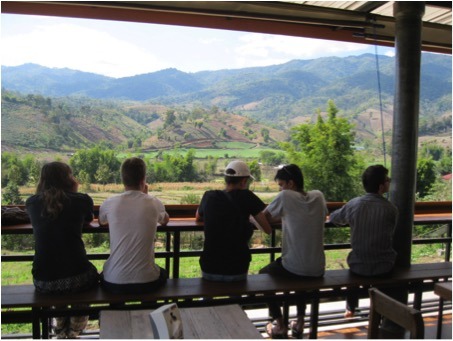
Our first visit to the refugee camp took us through the small town and out on to hard-packed, rutted clay roads which even Noi had to go easy on. The impression the camp gave on arrival was one of calm and quiet. There were many dogs but they were all passive. The buildings were simple wooden constructions, some with thatched rooves but most of sturdier materials. Everything was very dry and dusty. It was sunny and hot and there were not too many people about. The older ones looked traditional in dress but the younger ones would not have been much out of place in Auckland. There were plenty of chickens too, and motorbikes. Satellite dishes protruded from some homes.
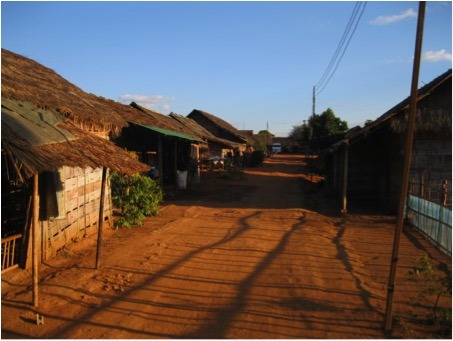
We were immediately sat down in a roofed space on plastic chairs and the camp leader, Sai Leng, a man in his 60s came to speak with us. His English was very good – he teaches English to children most evenings – and he asked us many questions as well as telling us about camp life, its history and the struggles of the Shan people in Burma. He is a calm, warm man to whom gentle humour comes quickly. We knew almost nothing of Burma but he gave us a clear picture of a nation made up of several distinct peoples with one, the Burmese, dominating ruthlessly at the expense of the others. He also set out how the life of the refugees had improved since the camp was started in 2003. Children were able to go to Thai schools relatively cheaply and could gain Thai citizenship if they succeeded at school. This would then let them enter the workplace legally in cities such as Chaing Mai.
Learning English is very important here – although the importance of Chinese is definitely growing. The camp offers evening English classes to local Thai children at the cost of 20 baht per month – about 20 cents per week! The people at the camp are able to pay for Thai medical treatment. Sai Lin ssaid this was affordable and for the old people, who need treatment more often, it makes sense to take out a policy for cover at about $100 per year. The camp members are free to come and go as they please, going into Piang Luang or returning to the Shan territory over the border if they wish. There is no difficulty for them with the Thai military or police.
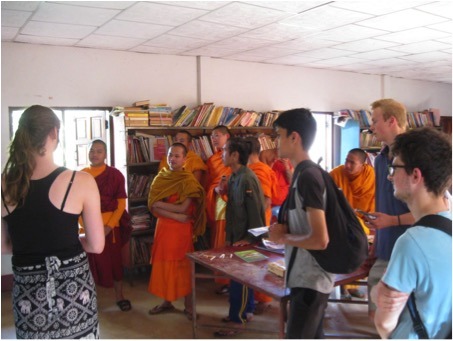
Returning to their Shan homeland is not an easy choice to make. The Burmese side of the border is strewn with land mines and life there is not good for the Shan people. More and more Burmese are settled there and the majority of Shan people is shrinking in size. They do not have freedom of speech there as they do in Thailand (where you must always respect the king and the Buddha) and they are poorly paid for their work. One very bright young man at the camp pointed out that the Shan people cannot look for full independence as life as a landlocked state would be too hard. They want the equivalent of what the Scots narrowly voted against in Britain. Sai Leng showed us great hospitality, always asking questions and answering ours clearly and freely. He was once a revolutionary and was shot in the leg in Shan state but now he lends his compassionate authority to ensuring progress for the people in the camp with a brighter future for their children.
There continues to be a great need for the outside world to lend both financial support and to put pressure on the Burmese government to ease the situation for the Shan people. Under his leaership, the camp was hardly the poverty-stricken place we had been expecting and it is a great tribute to all the people in this region that conditions get better as the years pass. The camp was so well settled that there really was no work for us to do! Our interest was warmly welcomed but the biggest contribution we could make was to help the monks and the children with English conversation. There are many monks here and they mix easily with the rest of the community. Most are quite young. They enjoyed playing hangman as well as just talking with us. There other passion is football and on our first visit, most of our students joined in their end-of-day game on a hard, dusty earth pitch that was carefully watered to give greater traction before the game started. It looked as if the ground was steaming as the work of the watering cans brought up clouds of dust! The camp children were also very keen to join in games with us. This was much more to their liking than learning English. We organised chasing games inside and outside the temple, dice games were played, throwing games and best of all, cricket with a branch and ball from our sports shed at school.
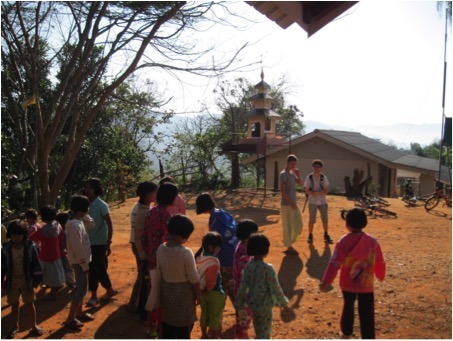
We had four nights in Piang Luang, a town without tourists, and the time went by very happily. There was much to take in and ponder, whether about the advantages we receive so easily in the West or what it would be like to have your home dominated by an unsympathetic, unkind power. I’m sure that we would have had other things to think through if we had seen the camp when it had started and there are probably camps in Thailand with much harsher conditions – this one is not U.N. recognised and that has its pros and its cons – but we got so much more out of our time here than we reckoned for and we all felt a strong connection with people so different to us but with such a fine outlook on life.
Written by Mark Thornton, Teacher at the Titirangi Rudolf Steiner School in Auckland, New Zealand
1 note
·
View note
Text
Teacher Training for Refugees
A Branch Foundation volunteer recently ran a two day teacher training workshop for asylum seekers and refugees in Bangkok.
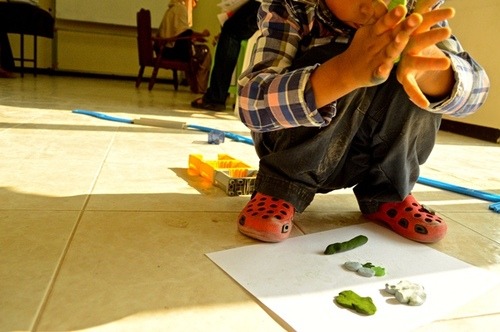
Many of the teachers are mothers of young children, who also were present for parts of the workshop. They enjoyed having access to the training materials!
Thailand, home to a large Burmese refugee population, is also host to an estimated 8,000 asylum seekers and refugees from Pakistan. Refugee Help Refugee (RHR) is a small, community-based organization which formed in December 2013 to address the needs of Bangkok’s urban refugees, particularly in the areas of community development, psychosocial support and education. One of their initiatives has been to form a community school, which holds classes for 85 children aged 5 to 15 in a modest room in an apartment building housing over 100 refugee families whose children cannot attend Thai school. The teachers in the school also live in the building and nearly all are women, teaching subjects including math, social studies, English and science. Most have no prior teaching experience, but many are also well educated, having earned university degrees in Pakistan.
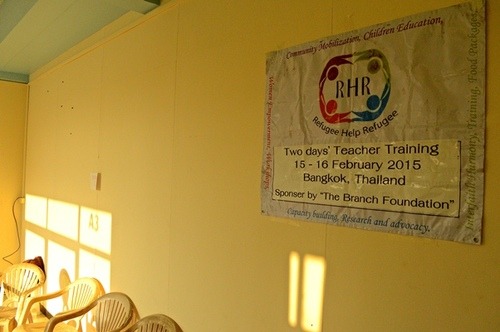
The training room, located in the same building where the teachers live.
The Branch Foundation’s two-day general teacher training workshop with RHR’s teachers was the first of its kind in this community, serving this population. Its focus was on the introduction of a “toolkit” of adaptable activities which could be integrated into a wide variety of subject-specific lessons and for diverse age groups. An integral resource and guide was Mote Oo Education’s Activities for the Social Studies Classroom, a book originally written for teachers from Burma, but whose games, tips and texts were also relevant in this context.
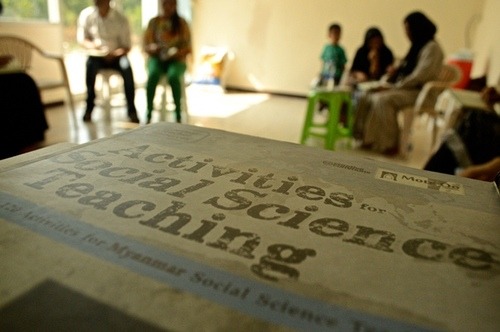
Copies of Mote Oo Education’s 2014 activity book were distributed to teachers and to the school library. Many of the games and activities in the training were derived from this resource, which was originally intended for use by Burmese teachers.
Attendance was optional, yet 14 of RHR’s 20 teachers voluntarily came to both days of the training. Teachers valued the emphasis on free and simple classroom resources, open discussion, and critical thinking. By the end, participants were able to recall with ease at least ten new activities which were introduced in this workshop and applicable in their classes. They were also able to explore solutions to under-resourced classrooms through a closer examination of their local environment, identifying learning tools which could be made with existing materials: string can be used as a storytelling aid, a homemade microphone as a tool to facilitate debate and peaceful communication, and decorated strips of paper awarded as “money” instead of points in games.
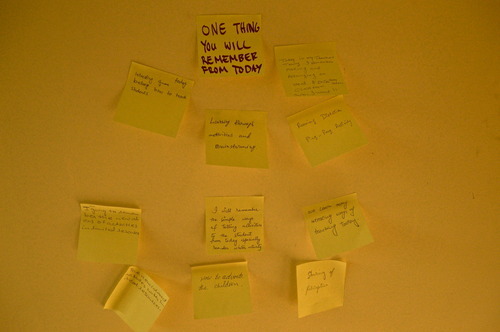
Halfway through the workshop, participants were asked what they would remember from the first day. “New ideas of activities [with] limited resources,” two teachers wrote.
Due to the efficiency of both TBF and RHR, a training like this can be organized for around $250, including travel costs for the teacher trainer, rental of the workshop room, homemade chicken biryani and handmade samosas for lunch for all participants, and certificates of completion once the training has finished. RHR is eager for more capacity-building opportunities. Teachers expressed an interest in future workshops on classroom management and effective lesson planning. The community at large is interested in further educational opportunities while they await the determination of their refugee status and eventual resettlement to a third country. In the meantime, there is a strong desire to continue to work to unite the community, to address the gaps in their children’s education, and to support each other through this period of uncertainty and upheaval.
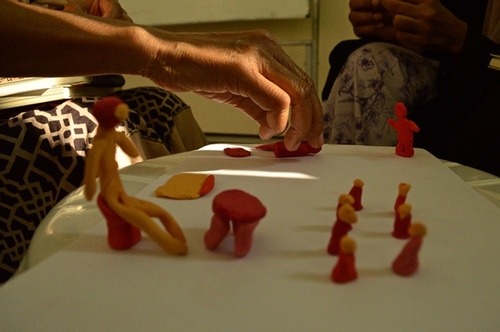
Teachers engaged in a form of community mapping, recreating their classrooms from clay. The activity was used as a catalyst to discuss the teacher’s role in the lesson, the layout of the rooms, and the resources available.
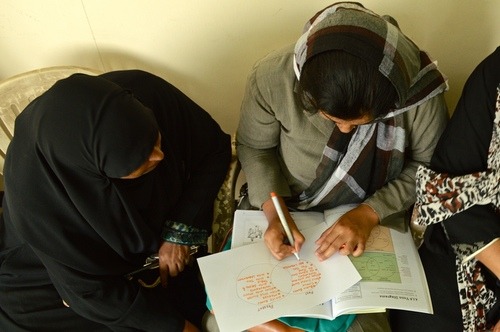
After interviewing a senior teacher about early education in Pakistan, participants were asked to vote on an activity that would encourage critical thinking about the information generated. They decided on a diagramming activity and compared modern education with that which was available in their country 30 years ago. “This activity emphasises the skill of categorizing data,” one teacher observed. “Students have to analyse the new facts and also incorporate what they already know.”
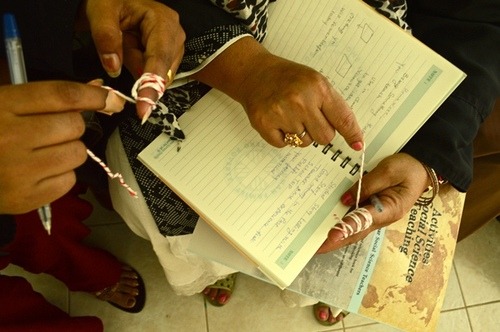
Utilizing an activity once introduced in Cambodian and Vietnamese refugee camps in the 1980s, teachers were taught how to use a simple piece of string as a storytelling aid—wrapping it around their finger for each event, until they reach the end. After trying the technique by describing to each other the process of how they became teachers, they generated a wide range of topics with which this activity could be used in their classes—from recalling historical events in social studies class to the more sensitive and challenging task of allowing students’ to retell their journeys to Thailand.
*All photos are copyright of The Branch Foundation*
0 notes
Text
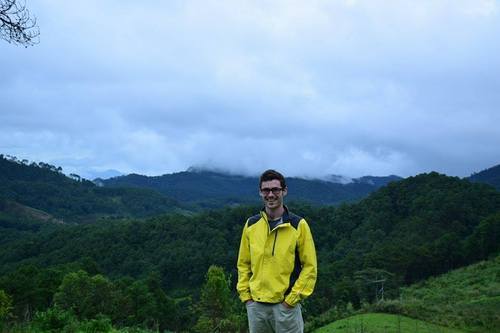
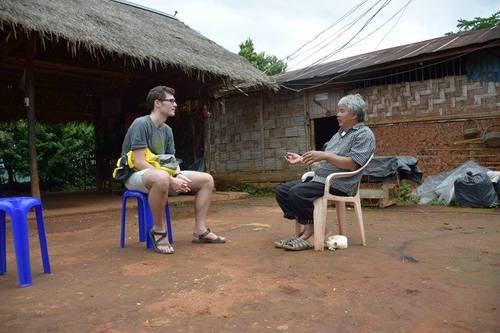

Written by Joe Gayeski - TBF IPS Intern at The Shan State Development Foundation.
Starting out in the field of international development is a challenge. Finding opportunities to build experience with NGOs or community-based organizations abroad is a difficult process, in which the seekers far outnumber the available positions. As a soon-to-be graduate keen to develop first-hand knowledge of development projects in Southeast Asia, I was lucky to end my internship hunt with The Branch Foundation and their Internship Placement Service. My internship with the Shan State Development Foundation has strengthened my understanding of development projects in Myanmar and Thailand, while also building the skillset necessary to make impacts in the field.
The Shan State Development Foundation is a community-focused NGO dedicated to improving conditions for thousands of internally displaced people (IDP) in Shan State, Myanmar. Based in Chiang Mai, their health, education, and development programs support 5 IDP camps along the Thailand/Shan State border. SSDF is the product of a 2013 three-part merger of separate organizations with a shared target area and congruent missions. My primary responsibility was to compile, edit and publish a comprehensive summary report of the recently formed organization’s projects, alongside a secondary task of teaching intermediate English writing. I began both projects not fully knowing what to expect: having just stepped off the plane in Asia for the first time, how could I have?
Both tasks were rewarding challenges. As the only person in the office who didn’t speak Shan, gathering information for the report proved tricky to start. I had to teach myself the ropes of desktop publishing to produce a professional report. With no prior teaching experience, my self-education included ESL lesson research and planning. I spent hours reading and gathering resources to create the most effective lesson I could. The challenges certainly paid off. By writing and editing content from project proposals and donor reports, I was quickly brought up to speed on SSDF’s history and current projects, and my English lessons proved to be productive and useful to the staff. The bi-lingual office and new tasks were the ideal opportunity to hone my skills in cross-cultural communication professional writing.
What wasn’t a challenge, however, was settling in to Chiang Mai. Thailand’s second-largest city proved to be the perfect place to get acquainted with the country. With its hectic roads right next to tranquil temples on the mountainside, it’s a bustling town that still manages to strike a balance between busy and relaxed. It didn’t take long at all to fall into the rhythm of the city. Within my first week, I had sorted out an apartment, a motorbike, and even joined the local ultimate frisbee team. Through the team, I’ve made friendships with both locals and fellow foreigners that will last beyond my time here. I’ve even become a proud supporter of the home football team, Chiangmai FC. Despite my new-to-Asia nerves, moving and living in Chiang Mai could not have been easier. My advice to anyone nervous about making the move would be to relax! After a trip to Wat Doi Suthep and your first meal of khao soi, you’ll never want to leave.
In my two months with SSDF, I wasn’t able to see first-hand any of SSDF’s projects in Shan State. As a farang, crossing the border into Shan State is difficult, if not impossible. However, I did get to look across the border into Shan State from the hillsides near Kuong Jor, a Shan refugee camp that works closely with TBF. The journey from Chiang Mai through the winding northern Thai hills to the border camp made the importance of SSDF’s work clear to me. I was struck by the commitment of a classroom of Shan monks to return home to teach English to the children of Shan State. I learned of the stories, politics, and details of the ethnic conflict through a long conversation with the camp’s director (not to mention the incredible Shan lunch we spoke over). I’ve become acutely aware that the ongoing civil conflict in Shan State has robbed thousands of their homes, livelihoods and futures. I am grateful for the opportunity to contribute to an organization devoted to empowering displaced people. Working closely with both SSDF and TBF taught me the impact that community-based organizations can have in conflict-affected areas, a lesson I’m certain to draw from throughout my professional and personal future.
*All photos are copyright of The Branch Foundation*
#refugees#burma#thailand#volunteering#internship#TBF#ssdf#intern#myanmar#comdev#chiangmai#volunteer#tbf#thebranchfoundation
2 notes
·
View notes
Photo
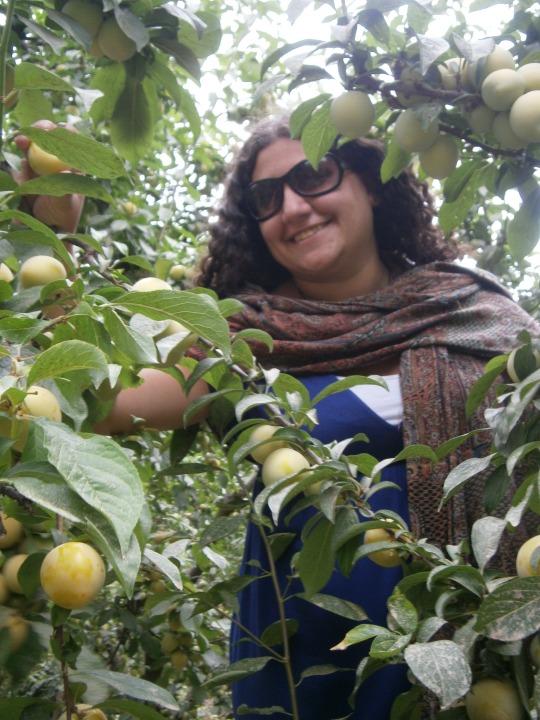
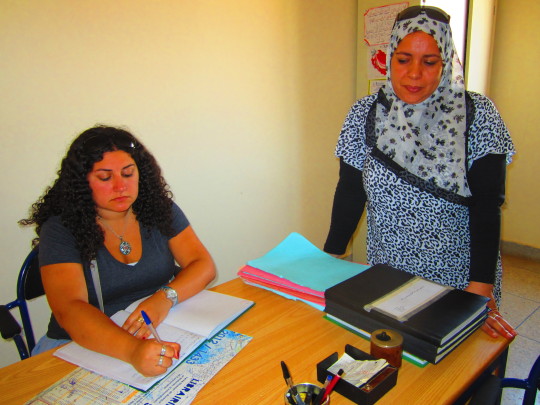
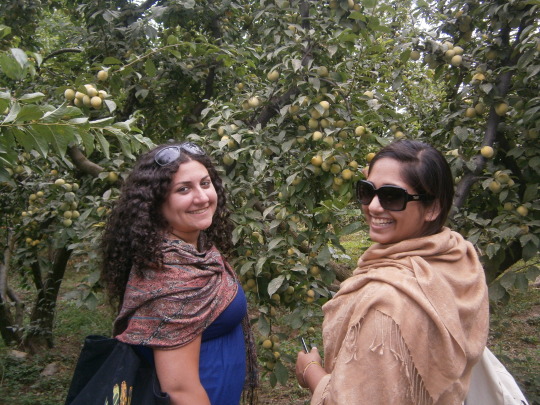
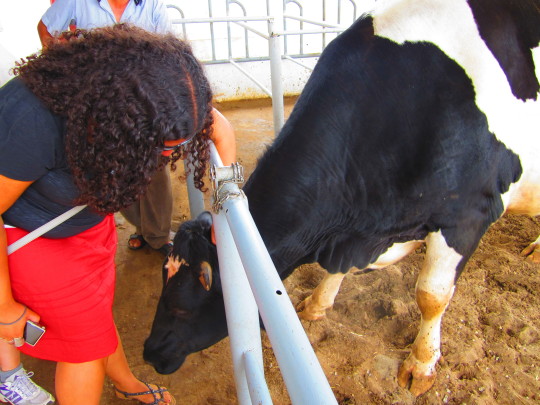
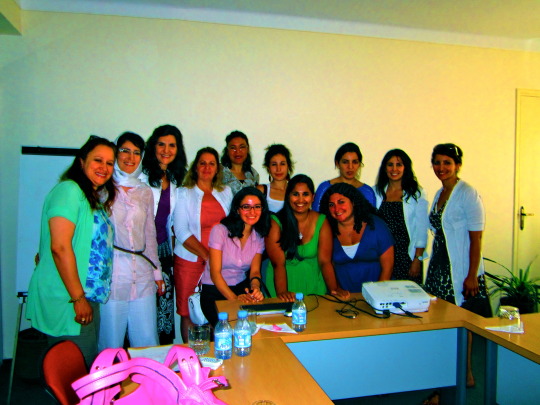
Written by Aliza Appelbaum, former In-The-Field Representative for GlobalGiving.
For anyone working in international development, one of the most rewarding experiences is the opportunity to work in the field and see firsthand the fruits of your labor. Having the success of a project pared down to the basics on a funding report or output chart is a necessary part of the job, but cannot compare to standing in an orchard with a proud farmer, eating a juicy plum plucked right from the tree, and knowing that your hard work helped that project succeed.
Last summer, as a graduate student studying international relations, I wanted an internship that would put me in the field, not behind a desk in an office. I already know my way around an Excel spreadsheet, and I figured three months of freedom between semesters afforded me a chance I could not pass up to experience development work in person. I spent the summer working in Morocco as a field representative for GlobalGiving, where I (along with The Branch Foundation's Fundraising and Advocacy Coordinator Shonali Banerjee) visited projects around the country for monitoring and evaluation, hosted workshops about online fundraising, and worked one-on-one with partner organizations to improve their operational capabilities. That’s the official version, anyway. More specifically: we drank tea and ate cookies with the residents of a children’s village in Casablanca, met some cows (and their human caretakers) at a farm school for troubled youth in Rabat, and learned about irrigation and soil erosion in the High Atlas Mountains outside Marrakech. Along the way, we met new people, were fed by every host organization, and got to explore and love an amazing country.
One of the first things I noticed was how important it is to show up in person. Speaking to a staff member in DC is helpful for when organizations have specific questions, but by sitting with NGO workers for a few hours, in their offices, we could provide a lot more assistance. When you are eventually back in DC or London or Auckland, it helps to have put faces and names with the email addresses; you’re not just working for an unknown entity, but rather making those calls and sending those emails and putting in that extra effort because it’s people you met and projects you saw, and you will find yourself more invested in the outcomes.
Making a more long-term commitment can seem daunting, especially when the internship is unpaid, as is often the case with development work. But the good news is that for small development organizations and NGOs, hours are as precious a commodity as dollars and euros. Parachuting in for a few weeks is a great way to get a taste of development work, but as with any pre-professional internship, the more time and effort you spend in the field, the more you will get out of the experience. At least for this former unpaid intern, the value I got out of the experience was more than worth the sacrifice of a summer’s wages.
Aliza Appelbaum graduated from Georgetown University in 2013 with a Master’s in Foreign Service. She lives in Washington, DC and sometimes tweets here.
*All photos are copyright of The Branch Foundation*
#GlobalGiving#global development#charity#internship#volunteer#southeast asia#morocco#wanderlust#travel
0 notes
Photo
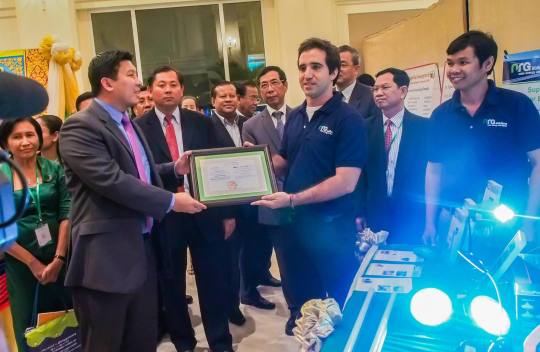
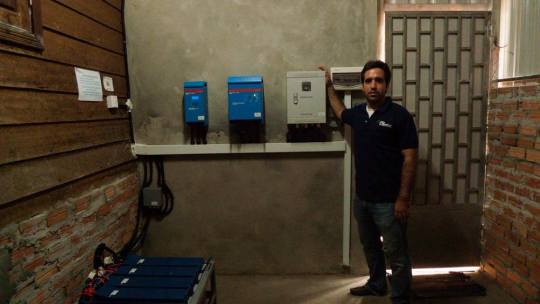
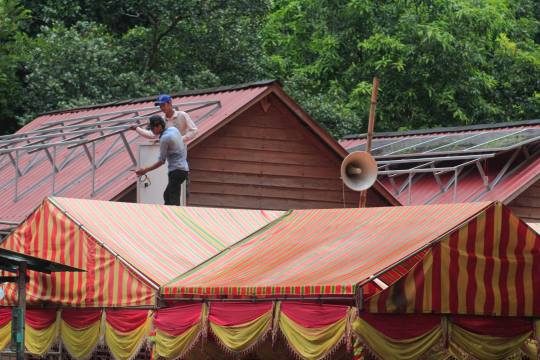
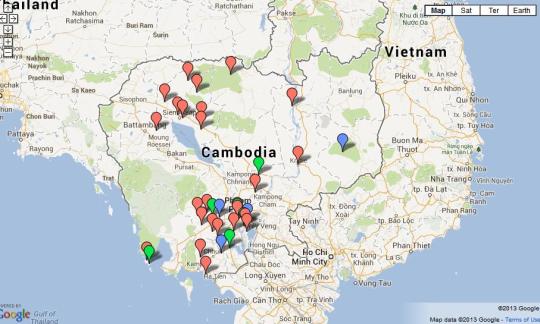
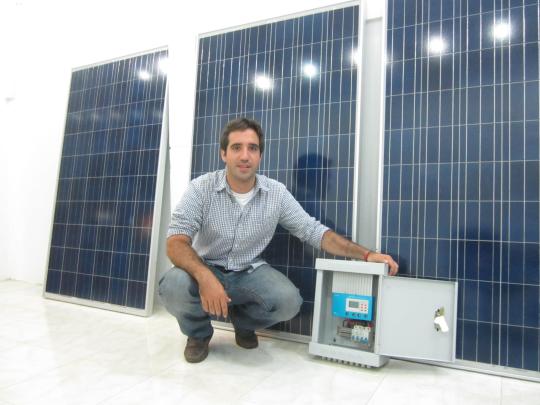
Written by Daniel Pacheco, Executive Director of NRG Solutions
“So, are you guys a company or NGO?” This is probably the most dreaded question for anyone trying to make a difference in either the for-profit or non-profit sectors. Trying to create change as a smaller non-profit comes with the burden of decades of previous failed international aid operations-- it's unsustainable and ineffective for making large-scale impact. But trying to make a difference as a for-profit company makes many question your character and intentions. Critics always seem to be saying, “How dare you make a living out of helping others?” The general answer chosen by many (including me) has been the “social enterprise” label. I make sure to never forget using the air quotation marks to try and avoid the cynical response such a loaded terms can generate in this community.
I'm an engineer who came to Cambodia over 4 years ago. After only a few months here, I saw the opportunity to create an impact for a large portion of the population by giving them access to electricity via solar energy. With this in mind, I had the chance to start working under an existing NGO. But it didn’t take long to run into some of the limitations of the non-profit sector. After many months ignoring the usual sentiments of “Oh that’s cute", "How very nice of you", and "But when are you going to start making a living for yourself?”, the real limitations of working as an NGO became apparent. There were legal and financial limitations, an over-dependence on donations and fundraising, and a general inability to attract investments to consider. On top of that, we were constantly concerned with being taken seriously by key players in this field, who’s support was crucial to our growth.
But ultimately two questions made me re-think the non-profit approach:
1. How can I make a truly sustainable difference working as a non-profit?
2. Is it really such a bad thing that I want to do charitable work AND make a living for my self? Why is it ok for my friend to make good money selling insurance, but I get frowned upon if I want to make a decent living while helping others?
We ultimately saw that as a non-profit, our growth and ability to invest in overheads to increase our capacity was significantly limited.
So together my colleagues and I decided that it was time to take action. We changed our name to NRG Solutions and launched as a for-profit company selling solar lighting, hoping we could then attract more funders. We believed that this would allow us to have a more sustainable model, both for the business and for our customers. But it didn’t take long to face the limitations of trying to make a difference as a company. Despite the initial interest in our projects and goals, a lot of eyebrows were raised when people saw we were a for-profit business. Thus, the “social enterprise” label came in very handy. Even though some cynics might still give us a look for using such a loaded term, it has made a big difference in the public perception about our work. It has now allowed our team at NRG to work hand-in-hand with both NGOs and for-profit companies. A recent example of this collaboration is our partnerships with a local NGO and a micro-finance bank. The NGO is helping us establish a national distribution network for solar energy products because they really liked our social mission. The micro-finance bank sees our potential profit and growth and chose to invest in NRG. Due to our label as a social enterprise, both of these relationships are now possible.
Overall, I truly believe that both the for-profit and non-profit sectors have a crucial role to play in the grand scheme of global development. Unfortunately, the rules and perceptions we impose on non-profit organizations and NGOs are limiting the impact they can have. This mentality has lead more of these organizations to adopt the for-profit model, forcing them to use the social enterprise terminology. Until a fairer and more inclusive playing ground is allowed-- one where non-profits are allowed to invest in overheads and growth, where they are encouraged to promote marketing, permitted to re-invest their raised capital to increase sustainability, and ultimately impact more people-- many of us will have to continue using the social enterprise label. We will continue using it even if it seems displeasing to some. I have experienced the benefits and limitations of both non-profit and for-profit approaches. I have no doubt that this for-profit/social enterprise model is by far the best in allowing for growth and sustainability, while allowing myself along with many others to make a decent living. It is possible to do all this while supporting local people and communities.
Although it's old and most of you reading this have probably seen it already, I would highly recommend watching this TED Talk by Dan Pallotta called "The way we think about charity is dead wrong". Whether or not you agree with anything I've said, if you have a response to this topic or any interest in the subject... watch that video. Nobody has been able to explain AND prove this issue so clearly. Watch until the end, when he even goes back in history to try to explain why we have got this whole debate on charity so “dead wrong”. I don't regret making the jump from non-profit and creating NRG Solutions. I just hope that with time, the global community at large will begin to understand the enormous benefits of an enterprise-based model.
Daniel Pacheco has a BA in Economics from Bard College and a BS in Engineering from Columbia University. Since 2009, he has lived in Phnom Penh, Cambodia, working with solar energy in both the for-profit and non-profit sectors. Daniel currently serves as the Co-Founder and Executive Director of NRG Solutions.
**All photos are the property of NRG Solutions**
#global development#solar#solar energy#renewable energy#charity#social enterprise#southeast asia#cambodia
0 notes
Photo
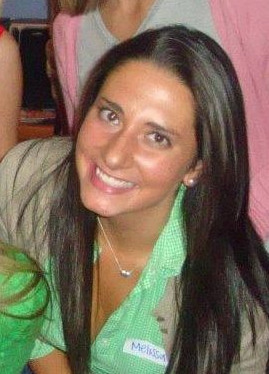
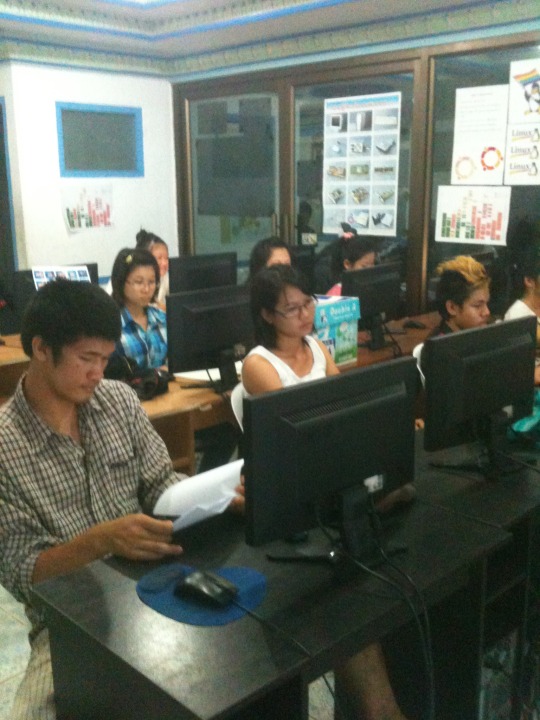
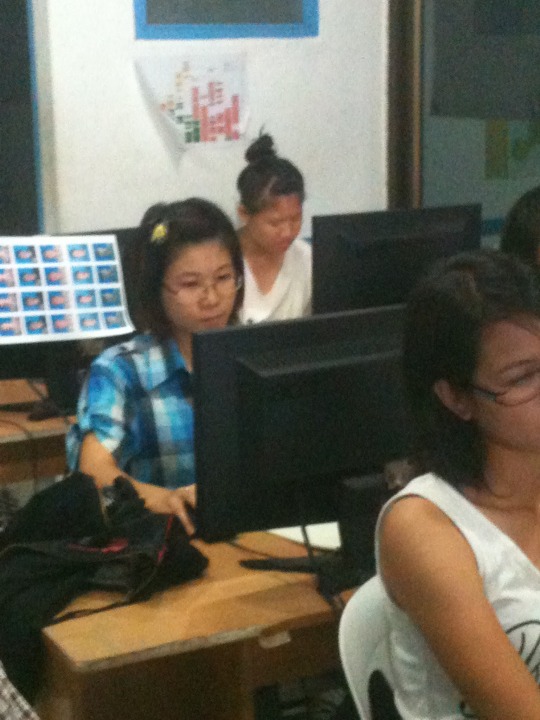
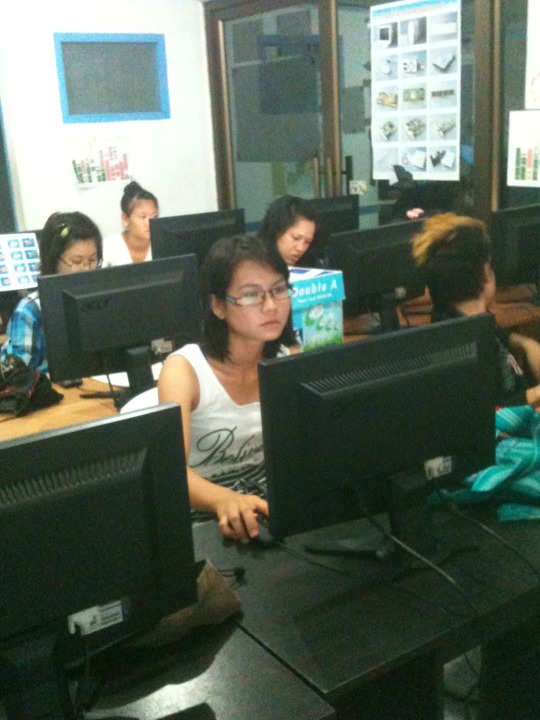
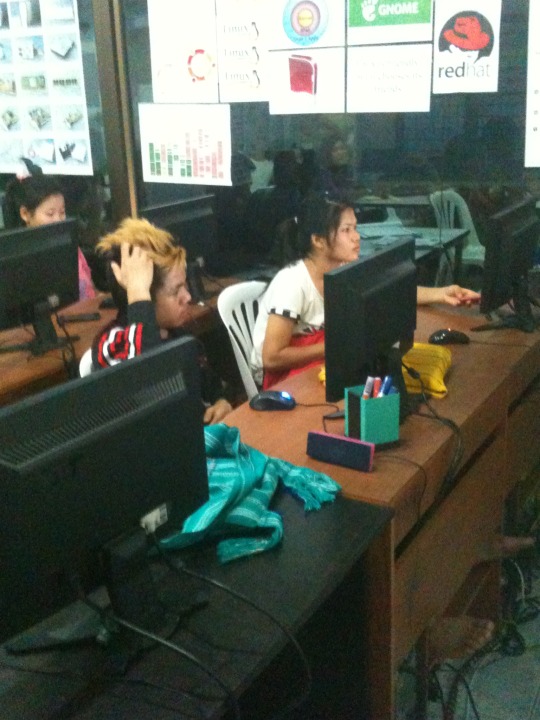
Written by Melissa Brobst, Grade 2 Teacher at Nakornpayap International School and Outreach Education Volunteer at The Branch Foundation
I can't even begin to express how amazing my first volunteering project with The Branch Foundation (TBF) was. When I first thought about moving to Thailand last year, the only thing on my mind was the reason I was coming: to teach. I was a new graduate, eager to begin my teaching career, and my sole focus was on landing my first teaching job. I never thought that by moving to Chiang Mai, I would be awarded the opportunity to become involved with such an exceptional organisation.
When Shonali (TBF Fundraising and Advocacy Coordinator) came to me with the idea of teaching a workshop on CV/cover letter/personal statement writing, I thought she was crazy. Why would someone want me teaching them how to write these crucial documents? I had just written my own for the first time and was definitely no expert. She began describing the project to me and by the end of her pitch, I knew this was something I couldn’t deny. I met with the whole TBF team and we began working on setting up the workshop.
TBF found this miracle of a volunteer, Glynnis, who wrote all the lesson plans and gathered more resources than I ever thought available for this workshop. With my plans in hand, I set off to meet my students at an organisation called Bridging Educational Access for Migrants (BEAM). This organization is for Burmese migrants who are studying for their GED in Chiang Mai. The students I worked with are between the ages of 18-30 and finishing up their GED studies with hopes of applying to University. I was a mixture of nervous and excited as I stepped into BEAM for the first time, but was immediately put at ease by all of the warm, welcoming gestures I received from everyone there.
When all my students finally arrived, we jumped right into learning about CVs. We talked about what needs to be included, looked at countless numbers of samples (thanks Glynnis!), and the students set off to start on their own. The first few classes were dedicated to CVs, what to/not to include and how to format the document in a style the student liked. It was amazing overhearing comments from the students during those first few classes. One student said she had no idea that anything she had done was actually considered important. Another said he couldn’t believe he had done so many things in his life and wouldn’t have realized it if he hadn’t written it down on paper. I could see how proud they were of themselves when they looked down at the finished CV they were holding in their hands.
We then moved on to cover letters and personal statements. This was more challenging for the students because they were essentially turning their CV into essays for potential university or job applications. Again, thanks to the copious amounts of materials Glynnis provided, we worked through these documents and each student completed a cover letter and was equipped with the tools to write a personal statement (if needed in their application).
You never know how a workshop is going to go. Especially with this one being new to both TBF and to me. But based on the feedback I got from the students, they really enjoyed it, learned a ton, and would recommend it to their friends. I will never forget these past 8 classes and the smart, dedicated students I met along the way. I can’t wait to continue working with TBF on Education Outreach programs like this workshop and potential other projects.
All photos are copyright of The Branch Foundation 2013. ©
www.thebranchfoundation.org
0 notes
Photo
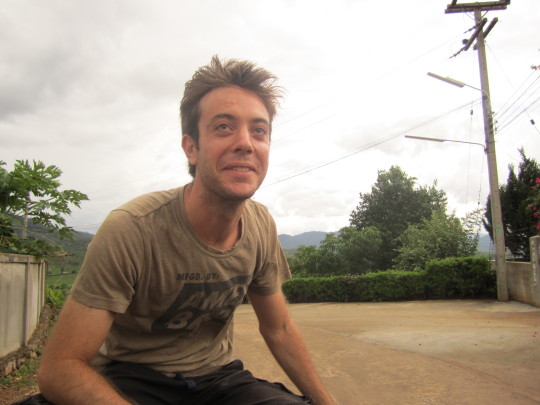
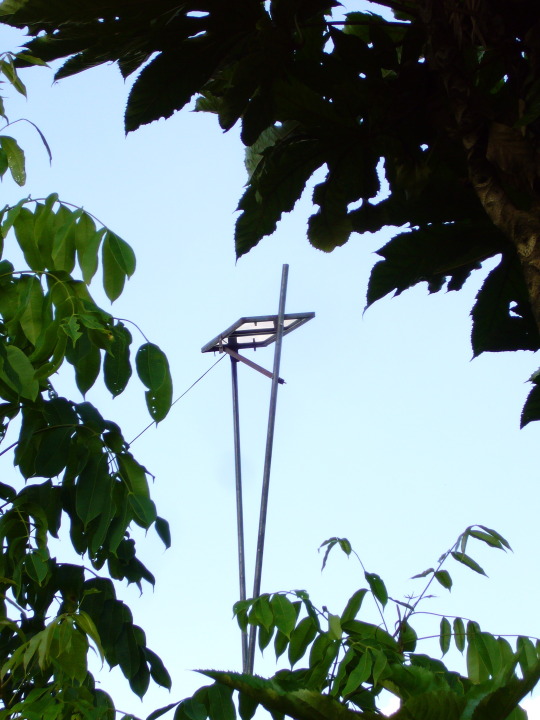
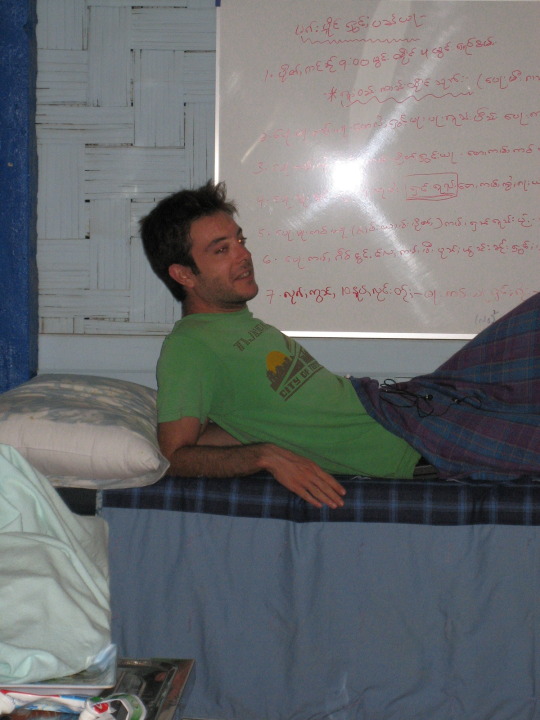
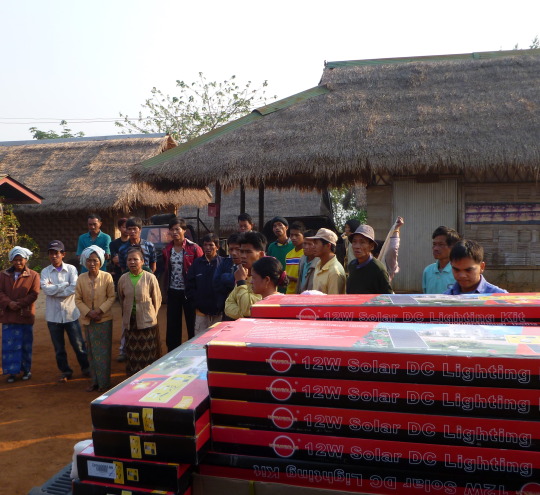
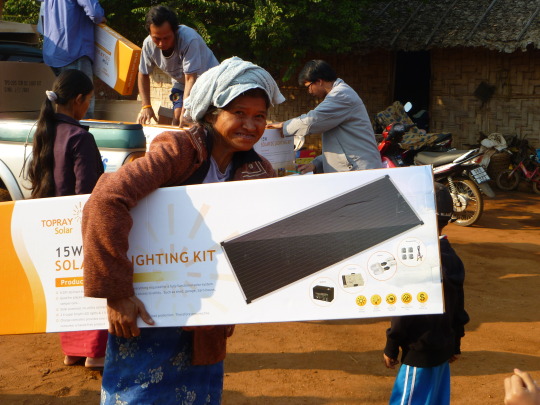
Written by Tom Rosen, Co-Director/ Project Manager at The Branch Foundation.
Firstly, I would just like to say that this is the first blog post I’ve written… ever. My fellow TBF staff members have informed me that a blog post is not like a report (the type of document I’m used to writing), nor should it sound like one. So with this in mind, I’m going to tell you a story – starting from when I first joined The Branch Foundation.
Nearly three years ago, I was on the back of a pick up truck holding on for dear life as it wildly negotiated the dirt road up to Koung Jor Shan Refugee Camp. I tried to look calm and collected in front of my new boss, Iona, whilst suffering from the mild whiplash I was slowly but surely obtaining during the ride.
Once we arrived, the Headman and other members of the community warmly greeted us. Apart from the delicious tea we drank upon arrival, one of the first things I remembered was the click-clack noise of the weaving centres. I finally got to see the weavers first hand as they worked hard to produce the scarves I had heard so much about. Iona, Katy (a videographer friend who came to film an advocacy piece for us) and I then took a tour around the camp.
I remember seeing a few solar panels dotted around the community and thinking it was very progressive of the camp to harness the sun’s power. However, I was quickly informed that these solar panels, many of them donated by TBF, weren’t just forward thinking but also the only way the residents could get energy for household lighting. The Thai authorities refused Koung Jor access to the main electrical grid as the camp is considered a temporary shelter.
That night, being the gentleman I am, I let Iona and Katy sleep on the proper beds in the camp’s clinic while I took the inspection table. My body was wider than the table itself, and it was about 4 feet from the ground – so it was to be a precarious night’s sleep for me. I was even considering creating a makeshift harness in case I tried to roll over in my sleep. As I lay awake (careful not to move my body), the solar panels really stuck in my head. There we were, right on the Thai-Burma border, and these people were using sustainable power whilst the towns and cities were still guzzling up the ever-decreasing, pollution-inducing gasoline.
Since that time, TBF ensured that every household had access to solar power for their lighting, effectively creating the world’s first solar-lit refugee camp. This means they are not only pioneers of green and sustainable energy, but they also save the money they had previously used to buy candles and kerosene lamps. These savings allow them to buy Yellow Beans (one of the only sources of protein they have access to due to their geographical restraints), which we used to provide the community. Now TBF no longer needs to do so. You can see that bringing one sustainable solution to the camp has had a domino effect and fosters further self-reliance. I’m very proud that we had a part in this endeavour and I hope that we can bring projects like this one to other communities in South-Asia.
As Western countries slowly struggle to see the benefits of green energy, it’s great to know that the community at Koung Jor have shed light on sustainable solutions and climate change. People around the world should look at these smaller communities, ones that took their own initiative rather than waiting around for slow-acting governments. Maybe then, everyone would be inspired to take matters into their own hands to create lasting change.
On behalf of all of us at TBF, Happy Earth Day!
All photos are copyright of The Branch Foundation 2013. ©
(Source: thebranchfoundation.org)
1 note
·
View note
Photo
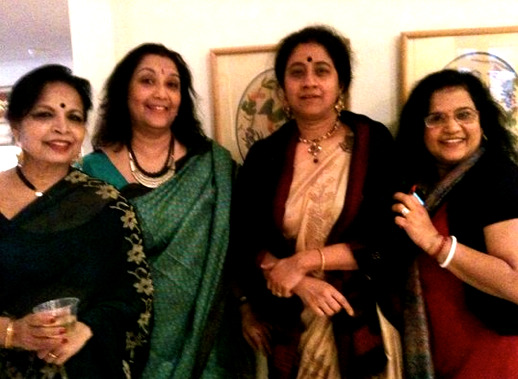
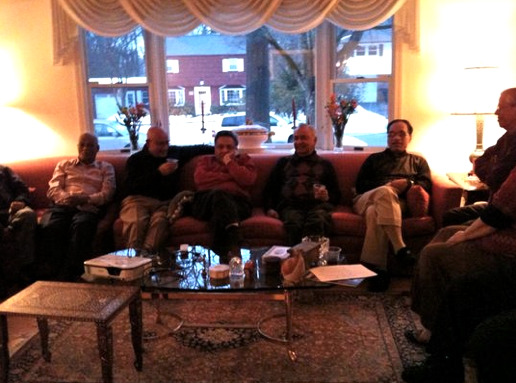
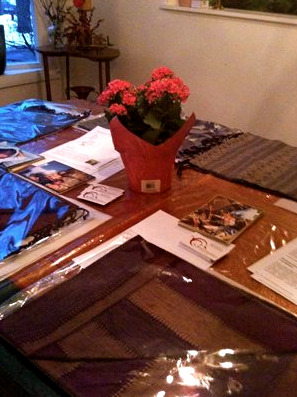
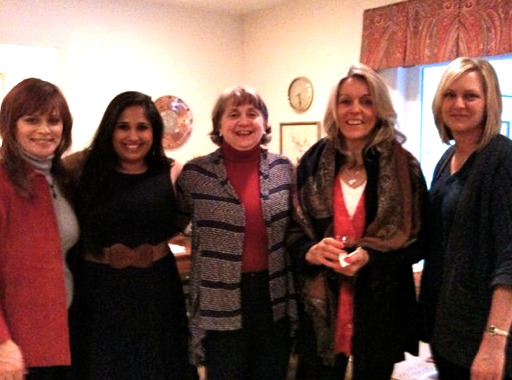
Written by Shonali Banerjee, Fundraising and Advocacy Coordinator at The Branch Foundation
Here's the thing you need to know about the Banerjees: we love to throw a good party. So back in January when I brought up the idea of hosting a fundraiser for The Branch Foundation (TBF) at my family's home back in the States, my parents loved the idea of throwing a dinner party for a good cause. They also enjoyed the opportunity to show their close friends that their daughter was not simply gallivanting aimlessly around South-East Asia.
I went back to Connecticut in early February and preparations for the fundraiser were in full swing. My mother was fretting over door prizes and my father was busy wondering what kind of wine is best served with Thai food, "Not red, then everyone will fall asleep during your presentation, we don't want that." Good point Dad, we definitely don't want that.
It was truly touching and heartwarming to see more than 40 of our family friends come to the fundraiser even after we changed the dinner party to an afternoon lunch at the last minute (the forecast called for snow in the evening... serves me right for hosting a fundraiser during the winter in New England). Nearly all of the guests had known me since childhood, and it was a very special privilege to share information about current development situations in South-East Asia and the truly inspiring work that TBF has been doing for the last 6 years.
Like my parents, many of their friends had immigrated to the United States from India. Because of this, I could see them empathizing with issues such as the necessity of education and enterprise development in marginalized communities, since they had witnessed these needs back in their home country. But the most pleasant surprise of the afternoon was the enthusiasm everyone voiced when learning about TBF's solar panel project at the Koung Jor Shan Refugee Camp. Initially I had been worried that our "new-age" renewable energy focus area would be the least appealing for this particular crowd. But I'd forgotten that many of the guests are engineers, and the idea of having a solar-powered refugee camp was completely fascinating to them!
I couldn't even begin to express my gratitude at the generous donations that the everyone made to TBF. Through this fundraiser (and some very wonderful matching funds on GlobalGiving Bonus Day), my family and I raised over $4,000 for capacity building and research into new TBF partnerships! Some friends were brave enough to try an online donation to our project through GlobalGiving. Others simply wrote checks which I later donated on their behalf.
This brings me to a really interesting point about the importance of hosting targeted fundraising events. Family friends handed checks to me when they walked in the door, well before they'd even heard what I had to say about the organisation. They of course stayed for the dinner and listened to my presentation highlighting many of TBF's successes, but the key point here is that they inherently trusted that 1) I was supporting an excellent cause with my work and 2) that I would make sure that their money got to the right place. Trust is the most important part of fundraising for any entity, and it is easily achieved with tailored, more intimate events based around close family and friends.
As a non-profit organisation, TBF is always looking for new, innovative sources of funding. But it's always essential for us (and other nonprofits!) to remember that even in this advanced era of fundraising online, making our websites iPhone friendly and Tweeting for change, our most successful fundraisers can come from something as simple as a staff member convincing her parents to throw a dinner party for their friends.
** I'd like to dedicate this post to Saumitra and Nasima Banerjee: thank you for your generous fundraising efforts on behalf of TBF, and for always teaching me the enormous importance of trust, charity and family.
(If you are interested in hosting a fundraiser for The Branch Foundation, please see here: http://www.thebranchfoundation.org/support-us/get-involved/)
All photos are copyright of The Branch Foundation 2013. ©
1 note
·
View note
Photo
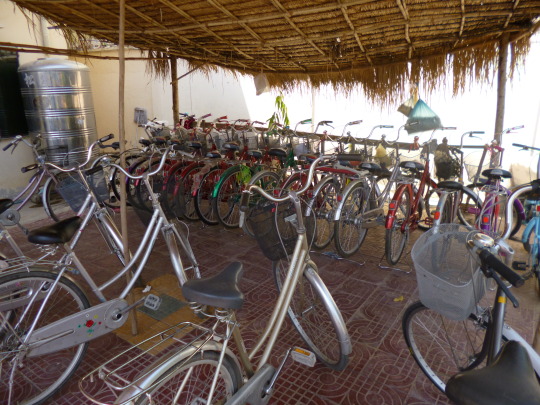
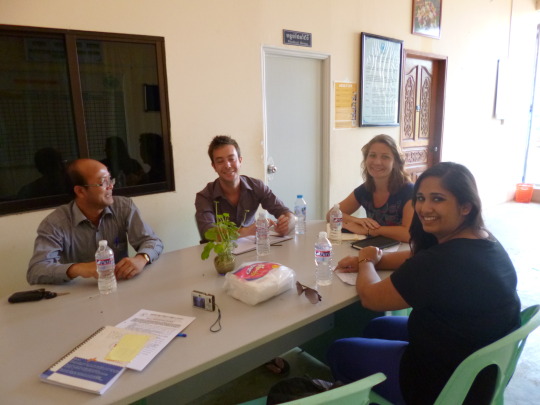
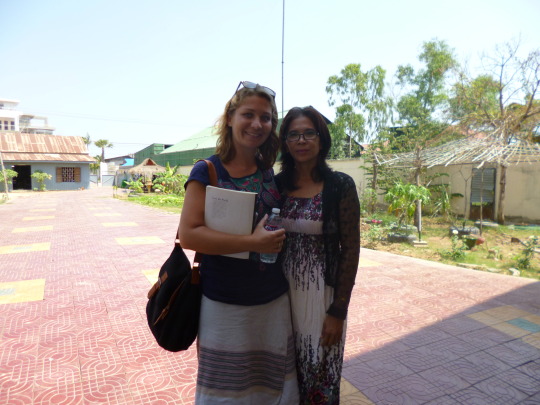

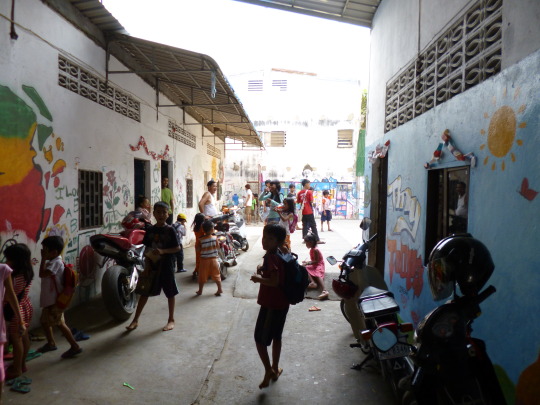
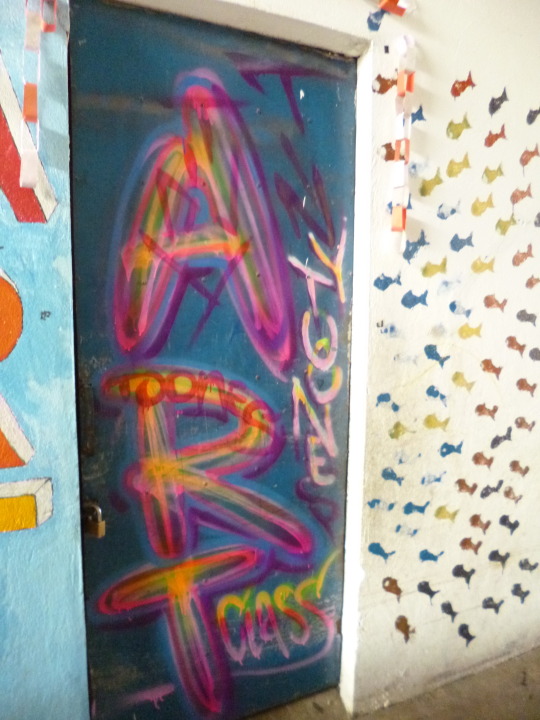
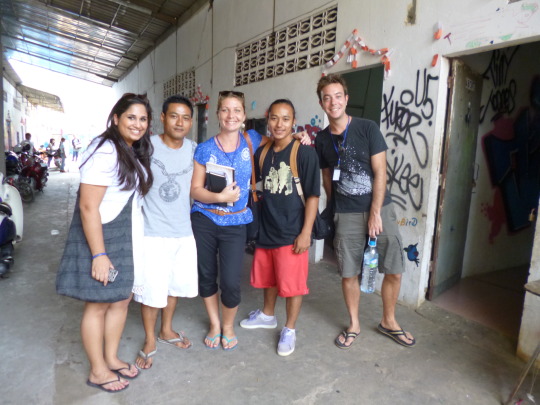
‘Sour Sdey’ (Hello!) from Cambodia…
Written by Iona Proebst, Founder and Executive Director at The Branch Foundation
Our Cambodia trip had been in the making for a while, so it was exciting to be up at the crack of dawn and on the plane to Phnom Penh. I have been to Cambodia many times before, but I had to laugh as our tuk-tuk wove amongst the early morning traffic, past tractor engine shops, makeshift road side garages and the usual morning commute with up to six people on one motorbike!
Tom (TBF’s Project Manager), Shonali (our Fundraising and Advocacy Coordinator) and I were in Cambodia for three reasons: visiting our partner organisation The Cambodian Center for the Protection of Children’s Rights (CCPCR), researching for Branch Services, a social enterprise we hope to launch later this year, and networking with as many people and organisations as we could. Our trip was seven days long and was divided between Phnom Penh and Siem Reap. The Cambodian humanitarian and development situation is very different to Thailand. Cambodia is still busy rebuilding a solid future after the Khmer Rouge regime, and this is present in almost every facet of daily life.
We have worked with CCPCR for just over one year and we were very eager to meet with the shelter director Mr. Thy to discuss the future of our partnership as well as visit the shelter itself which houses vulnerable girls and young women.
The shelter manager and counselor is one dedicated, simply inspiring woman. I carefully weaved my way through sensitive questions, which she eloquently answered. She has a holistic approach to dealing with the girls’ past, present and future mental health. She is a firm advocate of music and art therapy, and the walls are covered in drawings that give the girls an outlet to express themselves. It was beautiful to see how loved, cared for and trusted the girls were with the shelter staff.
Looking out into the dusty parking lot, I noticed a vegetable garden to the right and a rather barren space to the left. When we asked what would make life a little brighter for the girls, the answer was simple: they wished for a playground and a flower garden. So in honor of International Women’s Day, which happened to coincide within the week of our visit, we pledged funding towards bringing some colour and fun to the shelter and making their wish come true!
We are currently discussing future funding of the shelter and will be sure to keep you updated. But I can give you a heads up and say it will be within our Education focus area! It was very humbling to see the girls come home from school on their TBF-funded bicycles, which we provided along with educational costs.
The heat in Cambodia is unbearable at this time of year, the roads pot-holed. On one afternoon we ventured out to meet Tiny Toones, an organisation founded by a former Cambodian refugee with the mission to ‘provide a safe, positive environment for at‐risk youth to channel their energy and creativity into the arts and education, empowering them to build self‐confidence in their daily lives, aim for better employment possibilities, and feel supported pursuing their dreams.’ Tiny Toones comes from humble beginnings and is now a bustling center of activity. We were greeted by many calls of ‘hello’ and could hear children actively engaged in English classes. It felt like a place of hope, of equality and of possibilities.
The purpose of our visit was to see if their was potential to collaborate as we felt that both the breakdancers at the Shan Refugee Camp and the Tiny Toones crew had much in common. The difference is that the boys in the Shan Camp do not have anyone to train, motivate and inspire them to pursue breakdancing. We are currently in the communication and development phase, so please be sure to stay tooned!
On a stop on the bumpy road to Siem Reap, I tried to venture out and order some local fish soup. It was a mistake as it turned out to be water with a whole fish roughly cut into slices (everything still intact) and a slice of lemon to make it sour. After that slightly traumatic experience, I stuck to the famous local Amok curry. I had not been to Siem Reap since 2006 and it now is not too far off from an Asian version of Las Vegas, with added extra large neon billboards and backpackers on the South-East Asian travelers loop. One thing that has stayed the same is the friendliness and openness of Cambodian people. Their sense of humor is quick and witty, and their warmness always welcoming. A small example, but one that had effect, was the Air Asia flight attendant who broke out into a Thank You song on arrival in Phnom Penh. Welcome to Cambodia!
All photos are copyright of The Branch Foundation 2013. ©
2 notes
·
View notes
Photo
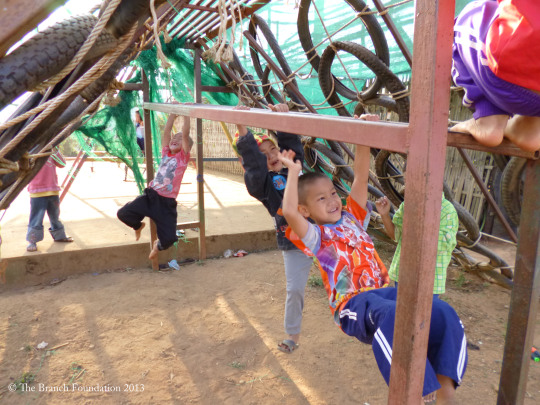

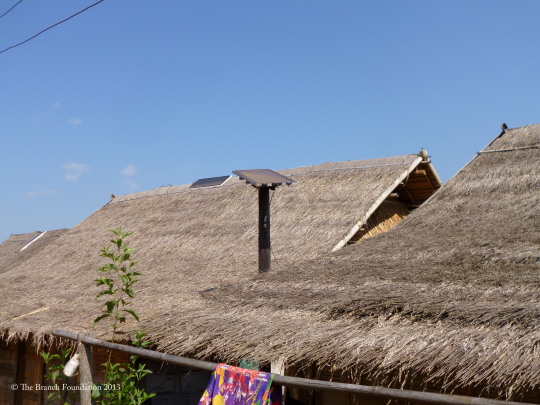
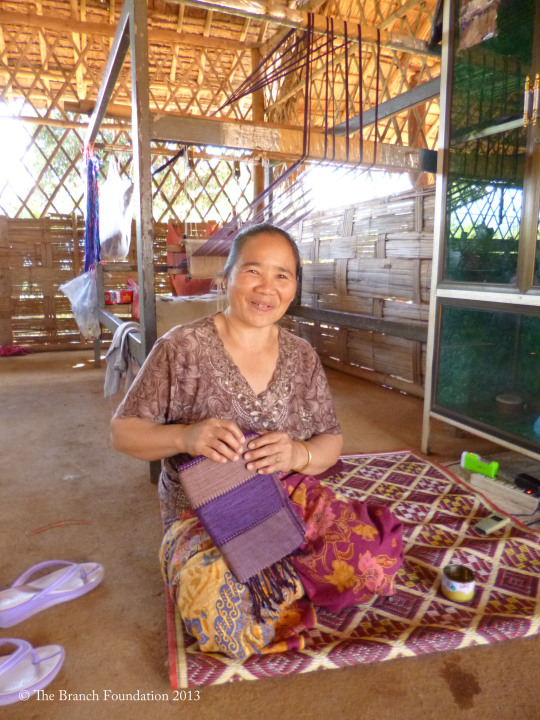
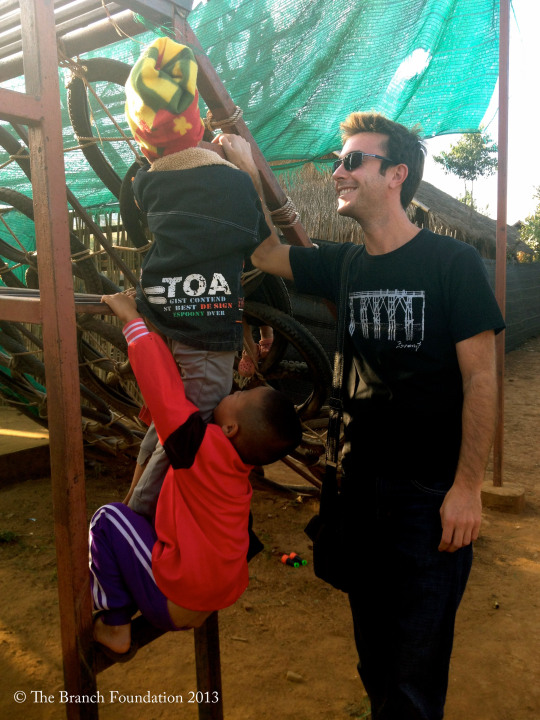
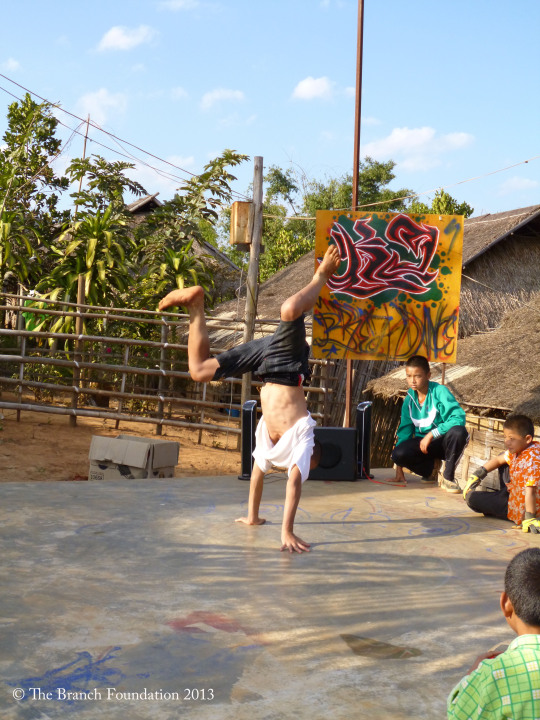
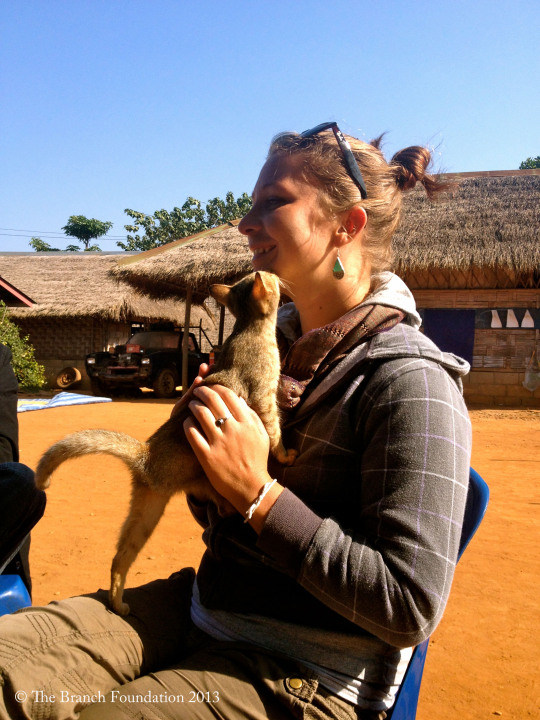
Written by Shonali Banerjee, Fundraising and Advocacy Coordinator at The Branch Foundation
Looking around the office in Chiang Mai, I’m surrounded by maps of South-East Asia and half-empty cups of tea. It’s tough to imagine myself just over a year ago, sitting in a windowless cubicle sifting through legal documents and watching the minutes tick by until 5:00pm. Somehow, after a year of multiple internships, dealing with cranky customers at a popular restaurant, and a sweltering summer in Morocco with GlobalGiving, I ended up walking towards the exit at Chiang Mai Int’l Airport, thinking, “I’m crazy for doing this… right?”
Probably. But after being greeted by Iona and Tom’s smiling faces and witnessing their enormous passion for the people The Branch Foundation (TBF) supports, I began thinking maybe I hadn’t entirely lost my marbles when I decided to jump ship on my life in Washington, DC and move across the world. But it wasn’t until the team took me up to the Koung Jor Shan Refugee Camp that I began to realize TBF’s truly enormous impact on local communities in the region, and how I could contribute.
When I initially heard “refugee camp”, tragic images of crying children and rows of blue tents came to mind. I never expected to arrive at Koung Jor— mere minutes from the Thai-Burma border— and see a flourishing community of smiling students, multi-generational families and emerging entrepreneurs. TBF’s invaluable mark on the Shan Camp became evident within the first few minutes of our visit. Solar panels glinted on the roofs of each home. Certified English teachers praised the progress of the children in their classes. Talented weavers worked tirelessly to replenish their stock of scarves, shawls and bags- they’d nearly run out from selling so much during the holiday season. Iona mentioned to me, “When I first visited the camp in 2009, the fundamental needs were much more apparent compared to today. Now the focus is on community development and sustainability. The changes within the community over the past few years are extraordinary and a real testimony to what can be collectively achieved.”
TBF recently amended its goals to focus on sustainable progress, shifting away from immediate poverty relief. Before visiting the Camp, I couldn’t help wondering how the organisation could be steering away from welfare funding when refugees are often in the direst circumstances. But that was before I saw the thriving camp, spent time with its inspirational community members and met with its forward-thinking leaders. I realized that TBF’s ambitious, self-sufficiency based projects had played a huge part in the progress of the Camp, which lacked so many essential necessities just a couple of years ago. Now, as the world’s first solar-powered refugee camp, Koung Jor (with TBF support) can focus on things like creating new enterprise opportunities and extracurricular activities for the kids.
As I continue to assist TBF in their advocacy and fundraising efforts, I’ll keep this initial Koung Jor visit in mind. I’ll think of how the Camp recently lacked clean toilets and mosquito nets. Now, it has a breakdancing troupe that learns their routines by watching YouTube videos on a solar-powered computer. I’ll know that I wasn’t crazy to take a leap of faith and move to Thailand, but rather, I would have been crazy not to.
To read more about The Branch Foundation’s life-changing projects at the Koung Jor Camp, see here or check out our Education project on GlobalGiving.
#global development#sustainable energy#education#refugees#thailand#burma#nonprofit#charity#globalgiving
1 note
·
View note